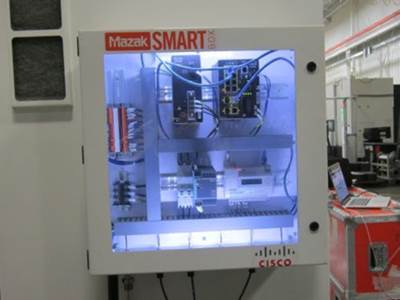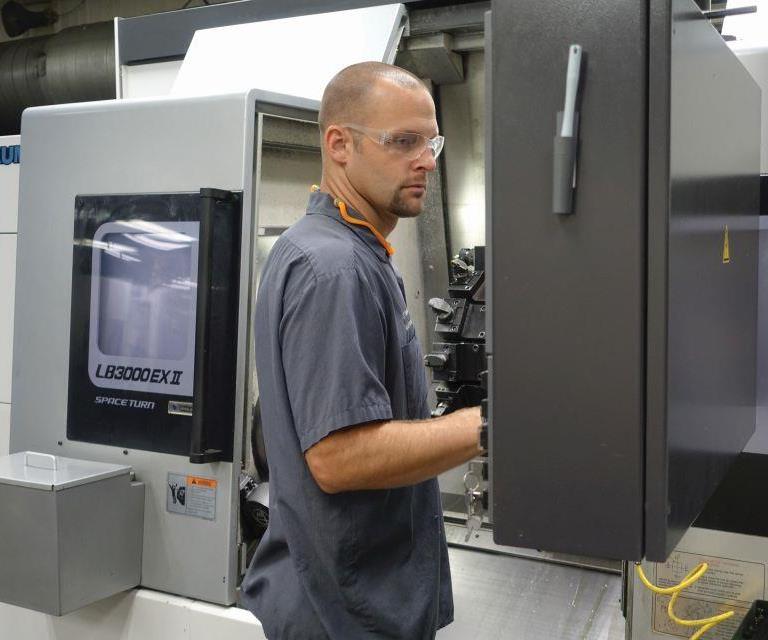Share




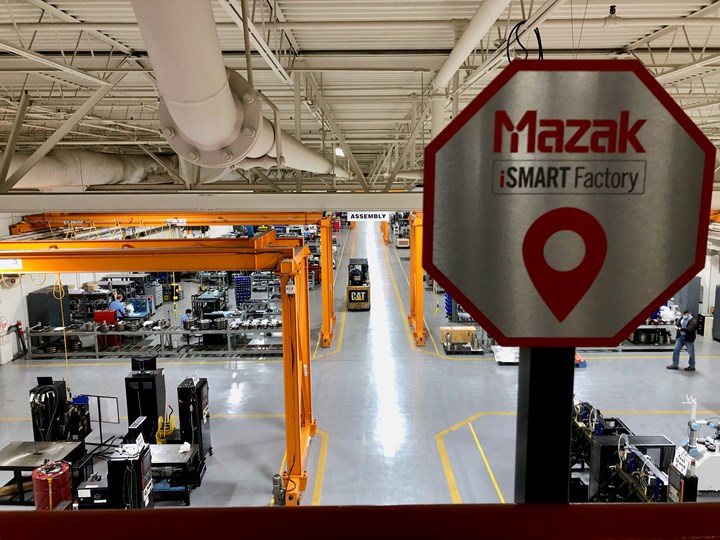
Mazak has incorporated its iSmart Factory concept for its North American headquarters. The concept calls for the complete digital integration of the factory and free-flow data sharing for process control and operation monitoring.
We so often write about job shops and the tools and technology those shops rely on that it can be easy to forget one important factor: The companies that manufacture these tools — including machine tool suppliers — face many of the same production challenges that machine shops and machine tool users do.
Mazak, for example, has been pioneering automation solutions for its customers for decades, building off of its Palletech system that launched in the 1980s as a solution that ties multiple machining centers together under the same manufacturing cell controller software. Since that time, the company has continuously updated this system, most recently by adapting and applying it to machine tool component production as part of an $8.5 million investment into the company’s own capabilities at its North American headquarters in Florence, Kentucky.
During a recent visit to this facility I had a chance to learn about this automated production line, including its automated storage and retreival system called the Mazatec Smart Manufacturing System, or SMS. Taken together, the system represents an integrated manufacturing cell designed to perform unmanned machining through the use of horizontal machining centers and multitasking machines, along with the material handling technology of Murata Machinery. Murata is best known for its expansive capabilities in material handling, and — in the case of the SMS — its vertically orientated, modular, six-level stocker-type system that includes pallets, automated load stations and high-speed stacker crane.
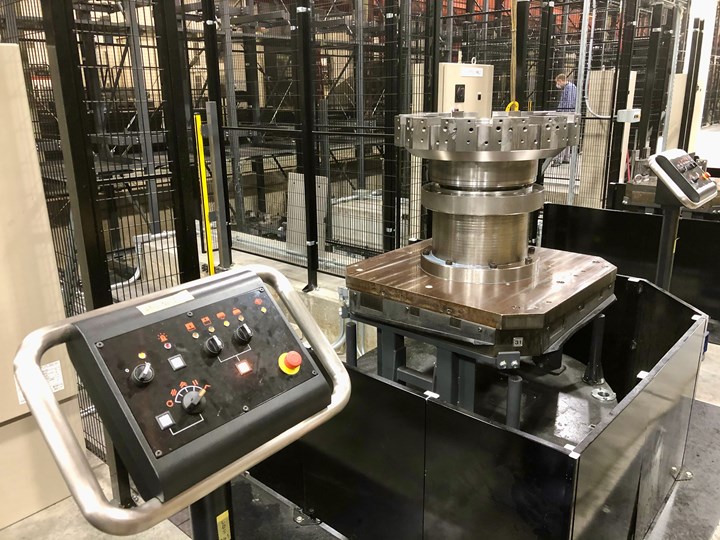
A machine tool turret is loaded on a pallet before finish-machining operations on the SMS cell.
As a whole, this unit can best be described as as a machine tool production unit, a demonstration facility, and a solution to the same struggles around skilled labor and lead times that Mazak shares with its customers as a manufacturer.

A line of HMCs in the Smart Manufacturing System cell in Kentucky.
Along with two Murata stocker systems, the core of the SMS cell consists of two HCN-6800 horizontal machining centers that accommodate 680 mm pallets, three HCN-8800 HMCs that can accept up to 1000 mm round pallets, and a Mazak Integrex E-1250 five-axis multitasking machine. Each machine is serviced by a tool transport robot that extends the effective tool capacity per machine to 1,800 tools. Each of these tools is stored either in a common tool hive or within the machines’ individual tool magazine, and each is outfitted with an RFID computer chip that stores information about tool performance and expected life.
Everything in the SMS cell — from the two stocker systems to the machine tools, to the coolant tank, to the Mazak SmartBoxes that are mounted to the side of each machine enclosure (more on that in a minute) — is connected to and commanded by a single cell controller.
The goal with this cell for Mazak is twofold: It uses it to produce major component parts for its mid-sized machining center product lines. This includes turret bases, carriages, sub-carriages and several other high-precision parts.
The other goal? To achieve the unmanned machining of these parts. To push a button and walk away. For hours. Or days. Many of the machining facilities we typically write about have this same goal. When I talked to the production personnel overseeing the system at Mazak, it became clear that some of the challenges in achieving this goal — and some of the ways this team and this system respond to them — are the shared by small and large machine shops alike.
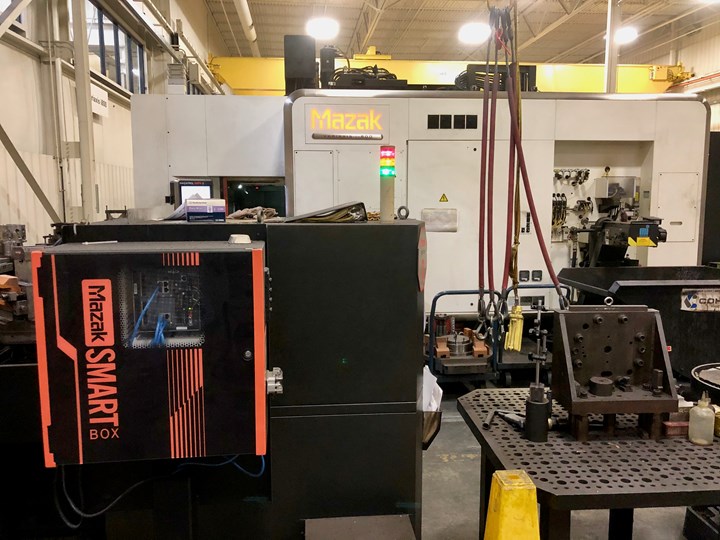
The SmartBoxes are edge-of-machine controls that provide data security to ease the connection of Mazak’s machine tools to a Web-enabled, plant-wide network.
Then vs. Now
The core concept of Mazak’s automated production cell has been around since the company first introduced its Palletech system. But it is the capability of the cell’s SmartBox IIoT technology and its manufacturing cell controller software that sets it apart from its own systems from years past.
These Smartbox devices are attached to each machine tool enclosure. They are edge-of-machine controls that provide data security and are designed to ease the connection of the machines to a Web-enabled, plant-wide network. When combined with Murata’s automated system control and Mazak’s production management software, called Smooth PMC, all components of the cell can interconnect and synchronize with a customer’s enterprise resource planning (ERP) host and manufacturing execution system (MES), in order to monitor operations, view and change schedules as needed, issue instructions, manage part program files and track tool life.
With this connectivity in place, a cell can handle system configurations that include up to 16 machines, anywhere from six to 240 pallets, and up to eight loading stations.
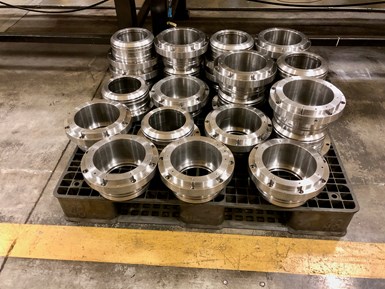
Headstock housings machined from gray cast iron castings on the SMS. These parts will reside on Mazak lathes sold to customers in automotive, oil & gas, mining and aerospace industries.
The goal then, and now, has been to optimize labor and allow a single operator to control multiple machines. Mazak first installed and configured a similar system back in 1988 after the company expanded its Kentucky facility, using the same concept of utilizing a material side and a pallet side for the stackers to feed several machine tools in a cell.
Rocky Rowland, Mazak’s flexible manufacturing facility manager, told me during a recent visit to the facility that the game changer for the SMS has been the automatic storage and retrieval system that ties different types of machines together, along with different pallet sizes, all of which are fed by a single stacker crane. “In the old system, we had two stackers, two racks, two rails, and two operating systems,” he says. “So it was just very difficult to try to control. But now we've combined those components together with new technology and are able to run all if it in one system.”
Kevin Sekerak, Mazak’s longtime plant manager at the Kentucky plant, estimated that his team is about halfway toward the goal of utilizing the SMS cell for unmanned machining that can take place over a weekend. COVID-19 interrupted his team’s progress toward that goal, of course, but so did the natural progression of new product lines for machine tools. New parts and components that Mazak introduced during the middle of 2020 meant pivoting toward a new batch of test cuts for these parts. But Sekerak and Rowland say that the goal of 100% unmanned machining for weekend shifts is on the horizon. The steps necessary to get there from here, they say, are already known.
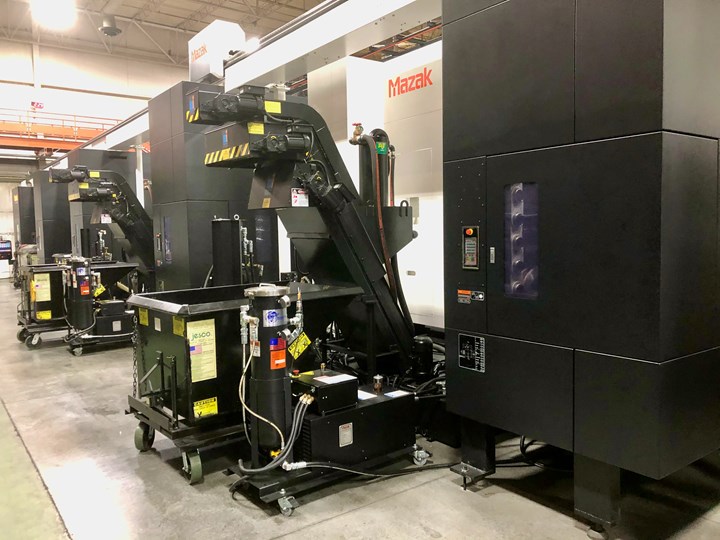
A chip conveyor services the SMS cell at Mazak’s North American headquarters.
A Different Kind of Chip
Here’s how Rocky Rowland explains the future life of a finished part for a Mazak machine tool manufactured on the SMS cell over an unmanned weekend shift.
All tools, including tool duplicates to last for a weekend, have been set up using a Zoller presetter. No matter if the tool manufacturer is Kennametal, Sandvik, Seco Tools, or another brand, the tool is equipped with an RFID chip that stores all the tool information needed for use on the system. This data is generated from cloud-based data from the various tooling suppliers, which is then loaded into CAD/CAM system (Mastercam, in Mazak’s case).
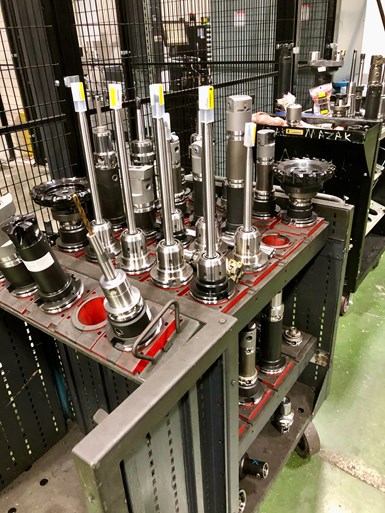
Tools ready to be services and run the the Zoller presetter before returning to the SMS cell tool hive.
The raw materials, typically castings, arrive. An operator loads the raw material from the process side to the material side of the cell, while another begins loading parts onto fixtures for first and second ops to ensure that they are ready for the machines. The coolant pans are filled. Enough pallets are loaded to run through the weekend — maybe 20 if you assume two-to-four-hour cycle times.
When all of these necessities are met, “the Palletech software says go,” Sekerak says. “Really, at that point, all operators go home. If we have 20 or 30 parts that are in the Palletech system, the machines just cycle through them one by one.” When the next machine becomes available, it pulls the part program from the network and begins to load tooling. The Palletech software then receives a signal when the part is finished. The scheduler locates the next part in line, loads the part program and readies the tooling. The software identifies where a needed tool is currently located, whether in the tool hive or in another machine, and uses the tool transport system to deliver it to the right machine.
When all criteria have been met, including spindle-mounted probing operations for in-process inspection, the process starts again and the cycle continues. “Then that part waits for the next operator to come in on Monday morning, whatever the time,” Sekerak says. “If the machines have finished, the operator places each part back in our finished material or raw material stacker, and then it's on to our CMM, unit assembly or our paint department. And that's a finished part.”
Repeat, repeat, repeat.
“What we hope to do with this system is unmanned operations,” Rowland says. The likely plan involves running two shifts while the third shift, and the weekends, are unmanned. “When labor is at a premium, it’s pretty powerful stuff when you think about running lights out and guaranteeing yourself that you have good parts coming off the line,” he continues. “So the expectation is that this line is an integrated, automatic system that is talking back and forth with our scheduling side, and being able to produce parts that meet print specifications. Let’s just call it like it is — it is easier to hire a lower-skilled operator than it is to find a senior machinist that has 18 years of experience. They're just not out there. We have to look at that variable and put that in place: How does that machine line help us manufacturer and make good parts by using smart technologies?”

An operator works with the Zoller presetter at Mazak’s Kentucky plant.
The Dual Customer
Until then, Sekerak, Rowland and their teams continue the transition by test cutting parts. Sekerak points to efficiencies already gained by the Palletech system, including 92% utilization of the machines during unmanned operations. “For machine tools, that's tremendous,” he says. “We expect that utilization if not better off of these machines. It's just a matter of keeping those spindles running.”
Large tool hives and heavy tool storage. Tool transport robots. Integrated network connectivity and in-process monitoring. All of these are necessary to achieve the kind of unmanned machining that Mazak’s system was designed to offer.
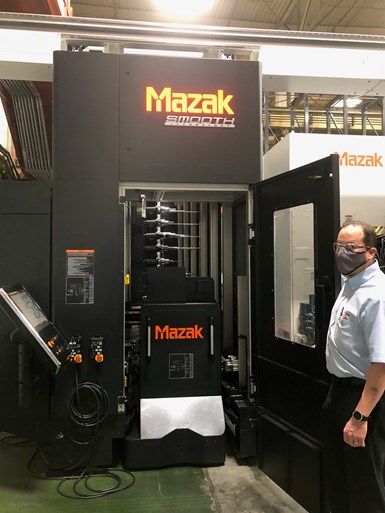
Mazak’s Kentucky plant manager Kevin Sekerak and Mazak’s tool transport system.
Add to that chip-integrated tools that interface with the SmartBoxes stationed on every machine — another layer of automation that is worth mentioning.
When operators command the tool transport system to retrieve tools from the hive or from a machine for maintenance, they bring the tools back to the Zoller preset station. Another operator services each tool one by one then loads it into the presetter. It reads the tool chip, measures the tool and loads the measurement information onto the tool’s chip. The operator is then free to place the tool back into the system.
“For tool offsets, there's nobody punching numbers into the machine that could then make a mistake,” Sekerak says. “It's all part of that chip data. The Zoller is providing the numbers that go through the chip onto the machine so there's no confusion.”
Taken together, all of this technology and the sizable investment it represents might seem to be out of reach for the smaller, mom-and-pop machine shops that form the bulk of U.S. manufacturing operations. So I asked Kevin Sekerak: Who is the manufacturer who may not realize that it could benefit from some version of what this system is capable of doing?
“If there is one last point that I have to make it would be exactly that: this is a modular, scalable system,” he says. “There are a lot of customers that could be operating at a smaller scale that can use the Palletech with one machine and six pallets. And that may be plenty for a shop to have one single operator and continue running through the night and still fully utilize that machine. Shops are facing overseas delivery issues right now. It’s just something that the world is going through, whether it’s port congestion or delivery problems with the overseas containers. And guess what? It could be a pandemic throughout the world, that can shut down that supply chain. The Suez Canal. You name it. We're trying to offer a wide spectrum, whether it's entry level machines up to highly advanced technology, but ultimately we're just trying to give our customers solutions. We like bringing customers in here and they can see that we're building the entire machine here in Kentucky. We're bringing in raw material, we're bringing in bearings, we're machining the castings, we are making the sheet metal and painting the sheet metal. We are assembling the materials and running our spindles and building a complete machine here. Our customers are fighting the same problems and asking the same questions about whether it's still profitable to manufacture in America. But we're doing it here, with the machines they can use.”
Related Content
Quick-Change Tool Heads Reduce Setup on Swiss-Type Turning Centers
This new quick-change tooling system enables shops to get more production from their Swiss turning centers through reduced tool setup time and matches the performance of a solid tool.
Read MoreThe Future of High Feed Milling in Modern Manufacturing
Achieve higher metal removal rates and enhanced predictability with ISCAR’s advanced high-feed milling tools — optimized for today’s competitive global market.
Read MoreHow to Successfully Adopt Five-Axis Machining
While there are many changes to adopt when moving to five-axis, they all compliment the overall goal of better parts through less operations.
Read MoreOrthopedic Event Discusses Manufacturing Strategies
At the seminar, representatives from multiple companies discussed strategies for making orthopedic devices accurately and efficiently.
Read MoreRead Next
What's So Smart about the Mazak SmartBox?
The Mazak SmartBox was showcased at this machine tool builder's Discover 2015 event. The company wants it to be the smartest (and securest) way to connect machine tools to the Industrial Internet of Things.
Read MoreFor Many Machining Facilities, the Mindset Now Must Be “Radical Automation”
What if there will never, ever be enough talent in your local labor pool to meet the still-growing demand for skilled manufacturing employees? The real challenge might lie in our expectations about how much skilled labor we need. Let IMTS 2018 be the beginning of facing this challenge.
Read MoreThe Role of Employee Incentives in Successful Automation
This shop doesn’t emphasize lights-out production so much as leveraging automation while the lights are still on. One key to this is a wage and compensation plan that rewards employees for maximizing automation’s impact.
Read More





















.jpg;maxWidth=300;quality=90)







